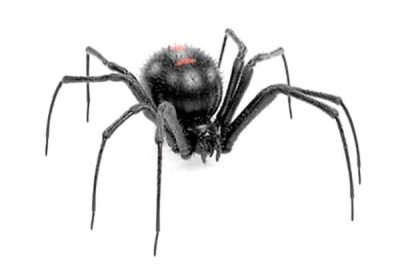Latin Name: Latrodectus Mactans

Black Widow, with the botanical name, Latrodectus Mactans, is a poisonous spider. They have a red hourglass shape on the underside of their underarm, which is a striking feature that makes them dangerous for potential predators. Reports show that the female eats the male after mating. It is rare because it mostly happens in captivity, and the male can’t escape.
Although it rarely bites anyone, its venom is 15 times stronger than a rattlesnake. The bite causes muscle pain accompanied by sweating, nausea, tremors, paralysis, fever, fainting, and increased blood pressure. In rare cases, the black widow venom can cause seizures and even death.
The Black Widow Spider contributes to the balance of the ecosystem by consuming insects like mosquitoes and flies. They feed on locusts, beetles, caterpillars, grasshoppers, and any pests that eat plants.
Like its name, the Black widow is shiny black but has a red hourglass on the underside of its abdomen. The markings are bright red and serve as a danger signal to predators and attackers. It has eight legs like many insects and is round in shape. They are about 1 ½ to 1 3/8 inches long (3-8 mm) and lack antennae. The females are sometimes brownish-black and larger (can measure up to 13 mm in length) than the males. However, the males’ legs are known to be longer than the females’. The males are also more colorful and finely patterned than the females. Their young ones are primarily white and orange but get their black color as they mature.
The black widow spider spins a giant web that suspends the female containing hundreds of eggs. They also use it to capture prey like flies, beetles, grasshoppers, etc.
Black widow prefers dark, secluded, and quiet areas, like woodpiles, crevices. You can also find them in dimly lit areas like dark corners, garages, cluttered spaces, patios, closets, and basements. They thrive in temperate zones, making them abundant in South America. Some species of the black widow are also present in North America. The most popular are the Latrodectus Mactans found in the Northeast, South America, and the Latrodectus Hesperus found in the west. There is also the Latrodectus geometricus found in the South and the Latrodectus various found in the Northeast.
Like many spiders, the black widow feeds on all forms of arthropods, from caterpillars, beetles, ants, grasshoppers, scorpions, cockroaches, and many others.
They process their food outside of their bodies. How? After they catch their prey in their web, the black widow injects the prey with digestive enzymes. They continue to do this until it is liquefied and softened. After feeding, the abdomen of the spider expands, signifying a full stomach.
The black widow can stay without food for several months, and some can even last a year without feeding on any prey. They also remain in areas that have tall grasses and piles of firewood or debris in attractive places.
An obvious sign of black widow presence is that webs would be hanging across the ceiling and on the wall. They are usually messy, irregular, and located at ground level. Also, they stay upside down with their hourglass markings exposed. Another sign is to find a silken sac containing eggs at the doorway.
The black widow has one of the most toxic spiders in the United States. They are beneficial because they eat many insects until the female spider attack humans when provoked. The venom from the female black widow is the same as neurotoxins that affect the nervous system. Though they rarely bite when they do, the bites are usually deadly and severe for elders and young children.
Look out for two light puncture wounds at the bite site if bitten. If the bite has some swelling and redness, the bite marks will not be visible. The severity of the bite depends on the bitten area, how sensitive the host was, and the amount of venom ingested.
The bite usually comes with muscle pain accompanied by sweating, nausea, tremors, paralysis, headache, fever, fainting, and increased blood pressure. In rare cases, the black widow venom can cause seizures and even death.
You can prevent the risk of the black widow because by doing the following:
If you suspect these pests are in or around your home, give us a call for a Free Home Inspection!
